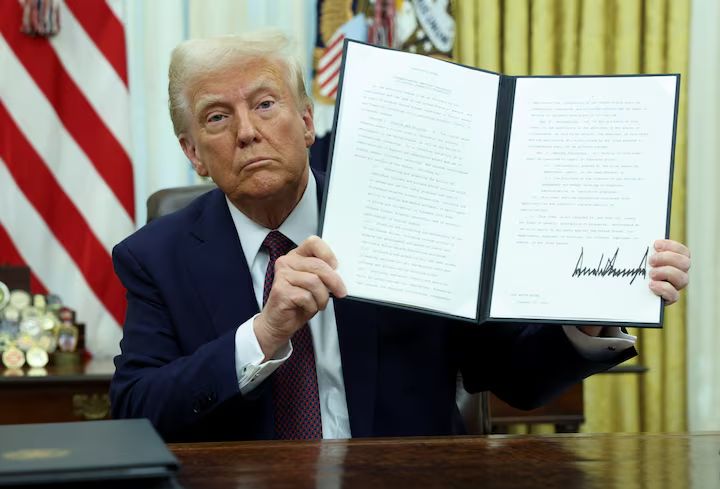On January 23, 2025, President Donald Trump signed a groundbreaking executive order that could reshape the landscape of cryptocurrency and digital assets in the United States. This move marks a significant shift in the government's approach to digital financial technology and sets the stage for potential American dominance in the crypto industry.
The Executive Order: Key Points
Creation of the Presidential Working Group
At the heart of this executive order is the establishment of the Presidential Working Group on Digital Asset Markets. This group, chaired by the White House AI & Crypto Czar David Sacks, includes high-ranking officials such as the Secretary of the Treasury and the Chairman of the Securities and Exchange Commission.
The working group's primary objectives are:
- Developing a comprehensive federal regulatory framework for digital assets
- Evaluating the creation of a strategic national digital assets stockpile
- Identifying regulations that may need to be rescinded or modified
National Digital Asset Stockpile
One of the most intriguing aspects of the executive order is the directive to evaluate the creation of a strategic national digital asset stockpile. This concept represents a significant departure from traditional financial reserves and could potentially include Bitcoin and other cryptocurrencies.
The proposed stockpile could serve multiple purposes:
- Enhancing national economic security in the digital age
- Providing a hedge against global economic instability
- Positioning the U.S. as a leader in the cryptocurrency space
Regulatory Framework and CBDC Ban
The executive order also takes a strong stance against Central Bank Digital Currencies (CBDCs). It explicitly prohibits federal agencies from undertaking any action to establish, issue, or promote CBDCs within the United States or abroad. This aligns with Trump's previously expressed opposition to government-controlled digital currencies.
Revocation of Previous Policies
In a clear break from the previous administration's approach, the order revokes Executive Order 14067 issued by President Biden in March 2022 and the Treasury Department's Framework for International Engagement on Digital Assets ref. This signals a shift towards a more industry-friendly approach, emphasizing innovation and economic liberty in the digital asset space.
Market Reaction and Impact
The cryptocurrency market's initial reaction to the executive order was mixed. Bitcoin (BTC) experienced a brief downturn, falling to $102,220 shortly after the order was signed7. This reaction was partly due to the absence of an explicit mention of a "strategic Bitcoin reserve" in the order, which some investors had anticipated.
However, the market quickly rebounded as the implications of the order became clearer. By the following day, January 24, 2025, Bitcoin had surged to $55,000, with Ethereum (ETH) following suit and reaching $3,200 ref. This dramatic price action underscores the significant impact of government policy on cryptocurrency markets.
The Shift in Trump's Stance
It's worth noting that Trump's current position on cryptocurrencies represents a significant evolution from his first term. During his previous presidency, Trump was notably critical of the crypto sector. However, his campaign for the 2024 election saw substantial financial backing from crypto investors and companies1.
This shift in stance could be attributed to several factors:
- The growing influence of the crypto industry in American politics
- The potential for economic growth and innovation in the digital asset sector
- The desire to position the U.S. as a global leader in financial technology
Implications for the Future
Trump's executive order sets the stage for potentially transformative changes in the U.S. crypto landscape. Here are some possible implications:
Regulatory Clarity
The directive to review and potentially modify existing regulations could lead to a more coherent and supportive regulatory environment for crypto businesses and investors.
Increased Adoption
With the government taking a more favorable stance towards cryptocurrencies, we might see increased adoption among both institutional and retail investors.
Global Competition
The creation of a national digital asset stockpile could spark similar initiatives in other countries, potentially leading to a new form of economic competition on the global stage.
Innovation Boost
By removing regulatory barriers and promoting a pro-crypto environment, the U.S. could see a surge in blockchain and crypto-related innovations.
Challenges and Concerns
Despite the potential benefits, the executive order also raises some concerns:
- The environmental impact of potentially increased crypto mining activities
- The need for robust consumer protection measures in a less regulated environment
- The potential for increased financial volatility due to greater crypto adoption
Conclusion
President Trump's executive order on digital assets represents a pivotal moment in the history of cryptocurrency in the United States. By establishing a clear policy direction, creating a dedicated working group, and exploring the concept of a national digital asset stockpile, the order sets the stage for potentially dramatic changes in how America approaches digital financial technology.
As the implications of this order unfold in the coming months and years, it will be crucial for investors, businesses, and policymakers to stay informed and adapt to the evolving landscape. The crypto industry stands at the threshold of a new era, with the potential to reshape not just finance, but the very nature of digital interaction and value exchange in our society.
FAQs
What is the Presidential Working Group on Digital Asset Markets?
It's a group established by Trump's executive order to develop regulations for digital assets and evaluate the creation of a national digital asset stockpile.
Will the U.S. government start buying Bitcoin?
The executive order doesn't explicitly state this, but it does direct the evaluation of creating a strategic national digital asset stockpile, which could potentially include Bitcoin.
How does this executive order affect cryptocurrency regulations?
The order directs a review of existing regulations, potentially leading to the modification or rescinding of rules that may hinder crypto innovation.
What is the government's stance on Central Bank Digital Currencies (CBDCs)?
The executive order explicitly prohibits federal agencies from developing or promoting CBDCs.
How might this executive order impact the global crypto market?
It could potentially position the U.S. as a leader in crypto adoption and innovation, which might influence other countries' policies and global market dynamics.
